One-hand watches: genius lies in simplicity!
.jpg) At mention of one-hand watch even the most enlightened man will be surprised. Someone is admired by it, and someone is simply bewildered. Today there are many watch companies that present one-hand wrist watches, striking by their simplicity and complexity at the same time. It’s hard to imagine a wrist watch with only one hand: our subconsciousness knows quite well the “beautiful couple”- hour and minute hands, and sometimes second hand. But everything was much simpler for ancient people: they measured their time, not so impetuous as today, with the help of only one hand, to say more exactly, with solar watch, forefather of all watches. And today the companies, creating their one-hand watches, are inspired just by them. Let’s start from the beginning! At mention of one-hand watch even the most enlightened man will be surprised. Someone is admired by it, and someone is simply bewildered. Today there are many watch companies that present one-hand wrist watches, striking by their simplicity and complexity at the same time. It’s hard to imagine a wrist watch with only one hand: our subconsciousness knows quite well the “beautiful couple”- hour and minute hands, and sometimes second hand. But everything was much simpler for ancient people: they measured their time, not so impetuous as today, with the help of only one hand, to say more exactly, with solar watch, forefather of all watches. And today the companies, creating their one-hand watches, are inspired just by them. Let’s start from the beginning!
The first watch on the Earth was solar watch. It was so simple that represented a genius construction: it was a usual pole, stuck into ground. A time scale, along which the pole’s shadow was moving, showing the time, was marked around that pole. The gnomon (pole) became the most ancient instrument for time definition: day time was determined by the shadow length. Soon the solar watches were created from wood or stone and set on the walls of main public buildings. Then portable watches, made of bronze, ivory or precious woods, came.
There were even watches-prototypes of early pocket watches. Those solar watches, found as a result of ancient city excavations, were made of silver-plated cooper and in the form of leg of pig with visible drawn lines. A pig’s tail served as a spire – watch hand. The watch represented a small movement and could be easily placed in pocket. But the ancient people, as far as we’re concerned, didn’t have pockets, and they wore those watches with laces, chains or fixed to canes from expensive wood. So the ancient ancestors acquired watches.
Ancient Egypt – a way through centuries
The first record on solar watches can be found even in the Bible. But the first 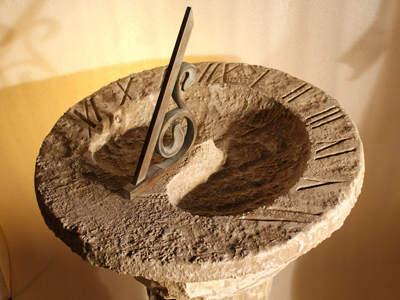 rather detailed description can be found in the tomb of Egyptian pharaoh Seti I, in far 1306 – 1206 before the Christ. The watch, described there, represented a rectangular plate with regular points. The time was defined by the shadow’s length. A bar with long horizontal shadowing stick was fixed to one end of that plate. The end of this construction was directed to the East, and the time could be defined by points, to say more exactly, the hour of day, which in Ancient Egypt was defined as 1/12 of time interval from sunrise to sunset. In the afternoon the direction of plate was changed to the West. Also there were two other types of solar watches in Ancient Egypt; their gnomon shadowed not a flat but inclined surface or steps. They had a considerable advantage: at morning and evening time the shadow was within the plate. Today in Cairo museum one can find a model of more ancient period from limestone, which combines all these three types of solar watches. This watch represents already two inclined surfaces with steps, one of which is directed to the East, another one – correspondingly to the West. In the morning, till noon, the shadow from the first surface slowly went down the steps, and in the afternoon it started going up the steps. rather detailed description can be found in the tomb of Egyptian pharaoh Seti I, in far 1306 – 1206 before the Christ. The watch, described there, represented a rectangular plate with regular points. The time was defined by the shadow’s length. A bar with long horizontal shadowing stick was fixed to one end of that plate. The end of this construction was directed to the East, and the time could be defined by points, to say more exactly, the hour of day, which in Ancient Egypt was defined as 1/12 of time interval from sunrise to sunset. In the afternoon the direction of plate was changed to the West. Also there were two other types of solar watches in Ancient Egypt; their gnomon shadowed not a flat but inclined surface or steps. They had a considerable advantage: at morning and evening time the shadow was within the plate. Today in Cairo museum one can find a model of more ancient period from limestone, which combines all these three types of solar watches. This watch represents already two inclined surfaces with steps, one of which is directed to the East, another one – correspondingly to the West. In the morning, till noon, the shadow from the first surface slowly went down the steps, and in the afternoon it started going up the steps.
All roads lead to Rome
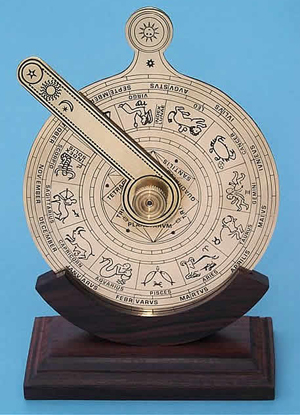 This aphorism could not have come at a better time, as the solar watches led us to Ancient Rome indeed, and also to Ancient Greece. According to Vitruvius’ records, in the VI century before the Christ an astronomer from Babel settled in Cos island. Thanks to him the ancient Egyptians knew about Babel solar watches. Those unusual and new for Greek people, as well as for us, watches had a form of spherical bowl - ñêàôèñà. Soon Àíàêñèìàíäðîì è Àíàêñèìåíîì started improving those watches. At excavations in Italy in the middle of XVIII century such device was found, just like Vitruvius had described. The ancient Greek and Rome people, like the Egyptians, divided the time interval from sunrise to sunset into 12 hours, therefore, their hour (as a time measure) was different, depending on a season. Soon such famous geometricians and astronomers, like Eudoxus, Apollonius, Aristarchus started creating different forms of solar watches. As for Rome, a solar watch first appeared there in 264 before the Christ. It was brought by a council Valery Massala from Sicily. But that watch lost its functional significance, as it was designed for more southern latitudes, and the time in Rome lost its way. The first solar watch, suitable for Rome latitude, was created in 170 by Marcius Philippus. This aphorism could not have come at a better time, as the solar watches led us to Ancient Rome indeed, and also to Ancient Greece. According to Vitruvius’ records, in the VI century before the Christ an astronomer from Babel settled in Cos island. Thanks to him the ancient Egyptians knew about Babel solar watches. Those unusual and new for Greek people, as well as for us, watches had a form of spherical bowl - ñêàôèñà. Soon Àíàêñèìàíäðîì è Àíàêñèìåíîì started improving those watches. At excavations in Italy in the middle of XVIII century such device was found, just like Vitruvius had described. The ancient Greek and Rome people, like the Egyptians, divided the time interval from sunrise to sunset into 12 hours, therefore, their hour (as a time measure) was different, depending on a season. Soon such famous geometricians and astronomers, like Eudoxus, Apollonius, Aristarchus started creating different forms of solar watches. As for Rome, a solar watch first appeared there in 264 before the Christ. It was brought by a council Valery Massala from Sicily. But that watch lost its functional significance, as it was designed for more southern latitudes, and the time in Rome lost its way. The first solar watch, suitable for Rome latitude, was created in 170 by Marcius Philippus.
Medieval art
In the middle ages the solar watches didn’t lose their popularity. The great treatises on solar watch design by such Arab astronomers, as Sabit ibn Corra, Ibn ash-Shatir, Abu-l-Hasan ibn Yunis, serve as an outstanding proof. The rules of trigonometry were applied for making those ancient complicated constructions. Besides hour points, the masters marked the direction to Holy Moslem city of Mecca at Arab solar watches. That direction indicator was named quibla. When the hours of day and night (the seasons were not considered) became equal, the problem of solar watch making was significantly solved: it was enough just to watch the shadow direction. In case of pin location in the direction of Earth axis, its shadowed the plane of time circle of the Sun, and the angle between that plane and meridional plane is the time angle of the Sun or real time. They only had to find an intersection of consistent planes with the surface of that simple construction. Mainly it was a plane, perpendicular to pin, i.e. parallel to celestial equator (equatorial or equinoctial hours), on which the shadow direction changed at 15 degrees per hour.
However, the solar watches were not a perfect time meter, as it showed only real solar time. The main task of exact science of gnomonica was plotting of curve on solar watch “dial”, which would point an “average” noon at different seasons. In Middle Ages such famous persons, as Appian, Albrecht Durer, Kircher, were doing gnomonica. An outstanding person of the XIX century Ìþíñòåð, who lived in the beginning of XVI century, was acknowledged as a “father of gnomonica”.
One-hand genius
In medieval period the solar watches, invented by Babel people approximately 3,5 thousand years ago, were replaced by first mechanical watches. Their most interesting feature was only one hour hand and crude German and Italian (old Czech) dial with 12-hour or 24-hour scales. The dial of medieval one-hand watch was provided with engraved Roman numerals. The floor watch with square brass dial of the same period was provided with scale, engraved in the very brass circle, fixed to non-round dial plate. All visible parts of dial plate around circle were adorned by engraved ornamental or cast brass relief appliqué, situated first of all in the corners of dial.
As the pendulum watches appeared, the watch movements became very accurate, and soon the dial acquired a minute hand. But that hand required a special minute scale, which was situated at outer circle of previous hour scale.
In the beginning the 5-minute intervals were marked by only Arab numerals. On the grounds of economy, the spaces in small dials were just parts of scale, but they were engraved or painted above hour scale in big watches.
The history of hour hands change is rather interesting. Initially the one-hand watches were provided with hands, which were situated at tetrahedral hour axle. The hands were provided with a bearing for hands adjustment by fingers and a nose at the opposite extension to manually rotate the hands more easily.
The one-hand spring watches of the XVI and XVII centuries were provided with rather interesting and complicated construction for that period. They were wound by a special key 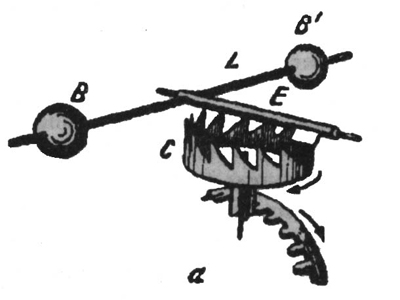 through aperture at the front of dial, later that tetrahedral of barrel axis moved to back. However, some models of Breguet watches, for example, were provided with tetrahedral at the hour hand axis. through aperture at the front of dial, later that tetrahedral of barrel axis moved to back. However, some models of Breguet watches, for example, were provided with tetrahedral at the hour hand axis.
The early one-hand watches were equipped with three-wheel movement. The main wheel was set at the axis of engine, and its motion was transferred to small gear wheel, which was situated at the axis with crown or running wheel. That running wheel had toothing in the form of saw teeth, situated perpendicularly to wheel axis. That wheel was an important and integral part of all trigger system, the main task of which was right adjustment of gearing motion speed. The energy of gearing was transferred to crown wheel, which spent the received energy on spindle rotation, which constantly touched the crown wheel. The spindle in its turn had two pallets, situated at the opposite of upper and lower tooth of crown wheel. The pallets were situated at an angle of 90 degrees to each other, hooking on crown wheel teeth in turn and rotating the spindle with pallets to one side, then to another. In case if a prominent tooth of wheel touched the lower palette and struck it, the spindle started rotating at its axis and, therefore, the upper palette entered into space between teeth in some time in the upper part of wheel. The upper tooth put pressure, which changed the spindle rotation to reverse. At each turn of spindle the running wheel tooth released and appeared at another palette. Therefore, the whole process repeated uninterruptedly. At each turn of spindle the wheel rotated at only one tooth. The spindle rotation speed was adjusted by a beam with loads, moving on it. When the loads moved closer to axis, the spindle started rotating faster and as a result the watch gathered speed. If the loads moved closer to edge, the watch correspondingly reduced speed. That was the concept of early mechanical watches.
Only one hand available is a special philosophy of time apprehension. Obviously, a medieval man didn’t think about transient time, that’s why a minute and especially second hand were not so important. The time was slow and easy. People were interested in not functional, but creative side of wrist watches. However, when a new century has come, the relation to one hand has changed: minute and second hands appeared. So, the relation to Time has changed: it has become rash and hasty.
Wrist watch “Einzeigeruhr” from “MeisterSinger” – special philosophy of Time and Life
 “Time is what you read at your dial”. Albert Einstein “Time is what you read at your dial”. Albert Einstein
From the moment of its first wrist watches the German watch company “MeisterSinger” follows its standards, which have become a distinguishing feature of all “Meistersinger” wrist watch models. Since the time of company foundation the watchmakers have been following the company’s motto: “Ïðîñòîòà ÷àùå âñåãî áûâàåò ëó÷øå âñåãî». MeisterSinger launched its first four lines in 2001, despite the crisis of watch market. The released lines won incredible success. The dials of all “MeisterSinger” watch models are adorned with a symbol, reminding of upturned fermata – a musical sign of unlimited time for notes and pauses sustaining. The wrist watch “MeisterSinger” like prompts its owner: “Rule over the Time, don’t conform to it”. This is the philosophy of Time creation, laid in “MeisterSinger” watches. For creation of its famous one-hand watches the company got its inspiration from watches of the XVII century, provided with only one hand. Then the traditional three- or two-hand watches would seem to be a wonder, so are the one-hand watches for us today.
The wrist watches “MeisterSinger” are distinguished among the rest by their unusual design. The watch internet magazine “Uhrenmagazin” published about “MeisterSinger” watches: “separately each detail the “MeisterSinger” watches are assembled from looks not very impressive, but all together assembled in one watch look just excellent!”. The limited series of “Einzeigeruhr” model, presented to sophisticated amateurs in only 75 pieces, serves as a proof of this statement. The model is a product of collaboration between watch company “MeisterSinger” and one of the most famous shops in Switzerland and whole Europe – Uhrsachen, situated in Swiss city of Bern. The wrist watch “Einzeigeruhr” is a rather interesting apprehension of time, presented by a single hand. The one-hand watch is presented by two versions: one model is provided with movement Unitas 6497, and the black dial is covered with sapphire glass. That version was released in 25 pieces. Another model is provided with movement ETA 2801, and the dial is covered with ordinary glass. Despite its black color, the wrist watch “Einzeigeruhr” has a bright design thanks to an orange hand, orange cuts and indexes. The black strap is made of leather and stitched with also orange threads. The one-hand watch “Einzeigeruhr” creates illusion of chronometric freedom. This is a watch for those who do not conform the transient time, but dictate their own life time.
Wrist watch “Azimuth”: «traveler’s route» in time and space!!!
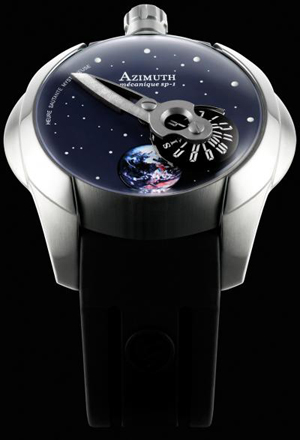 The Swiss watch company “Azimuth” The Swiss watch company “Azimuth”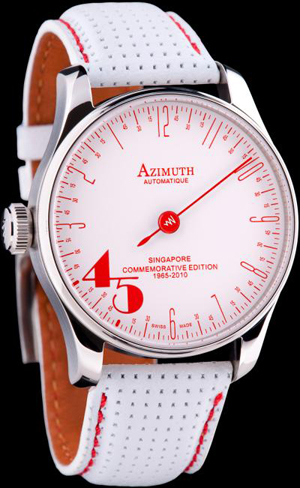 is a prestigious manufacture, presenting unique watches-concepts, reminding of futuristic chronometers, to strict connoisseurs. The wrist watches of Azimuth are a combination of futuristic aesthetics and progressive technical constructions and various complications. Azimuth supplemented the list of Swiss watch manufactories in 2003, and since that time it hasn’t stop amazing the watch world with its revolutionary and unique watches, interpreting the apprehension of time in its own way by means of exact sciences. Just the name of company “Azimuth” (a geodesic term, meaning the angle between North and direction to some distant thing, which is measured usually by watch hand movement) fully reflects the main concept of company: definition of both time and location. The word is derived from Arab “as-simt”, which means “the route of traveler”. The company’s emblem is a spiral that perfectly emphasizes the company’s specificity – manufacture of high quality just mechanical watches, as the spiral is a heart of mechanical watches indeed. As the watch company “Azimuth” with its chronometers, perfectly combining ancient traditions of Swiss watch art with innovative concepts, appeared, a new page opened in watch industry. is a prestigious manufacture, presenting unique watches-concepts, reminding of futuristic chronometers, to strict connoisseurs. The wrist watches of Azimuth are a combination of futuristic aesthetics and progressive technical constructions and various complications. Azimuth supplemented the list of Swiss watch manufactories in 2003, and since that time it hasn’t stop amazing the watch world with its revolutionary and unique watches, interpreting the apprehension of time in its own way by means of exact sciences. Just the name of company “Azimuth” (a geodesic term, meaning the angle between North and direction to some distant thing, which is measured usually by watch hand movement) fully reflects the main concept of company: definition of both time and location. The word is derived from Arab “as-simt”, which means “the route of traveler”. The company’s emblem is a spiral that perfectly emphasizes the company’s specificity – manufacture of high quality just mechanical watches, as the spiral is a heart of mechanical watches indeed. As the watch company “Azimuth” with its chronometers, perfectly combining ancient traditions of Swiss watch art with innovative concepts, appeared, a new page opened in watch industry.
The wrist watch “Azimuth Spaceship” from SP-1 series is an outstanding example of company’s specific vision. That watch-concept was named “Spaceship”, which perfectly reflects the essence of concept. The dial reminds of spaceship illuminator, rushing over expanses of Universe and opening a view to our beautiful Planet through a mysterious stars scattering at resin-black sky. The men watch “Spaceship” is a rather “serious” and massive construction. The case of 45 mm diameter is made of high quality stainless steel. This “spaceship” works on manual winding movement UNITAS of caliber 6497-1 on 17 jewels with “Cotes de Geneve” finishing. The watch is provided with function of “jumping hour”, performed by 3D hand and rotating disk with hour indexes, coated with Superluminova. The Earth makes a rotation per 60 seconds. A fascinating dial is covered by solid dome-shaped sapphire glass that gives a visual 3D effect to watch. The crown is situated in upper part of case that is much more comfortable in use. The strap is made of rubber. The water resistance makes up 30 meters. The watch “Spaceship” from Azimuth is a true unique creation one can’t take his eyes off.
However, despite the various models of concept watches, in 2010 the watch company “Azimuth” presented the wrist watch “Azimuth Back In Time” (Singapore Commemorative Edition), which has become a worthy supplement of Round-1 series, distinguishing by its traditional design and quite bright colors. In spite of its simplicity, the watch “Back In Time” (Singapore Commemorative Edition) is a real festival for eyes, perfectly combining white and red colors. The issue of that model marks the 45th anniversary of Singapore independence, obtained in 1965 by separating from Malaysia. This significant date – 1965-2010 – is marked on the watch dial. The “4” and “5” numerals are rather big, as compared with others, softly alluding to jubilee. The color range of watch is performed in accordance with colors of Singapore flag. The white dial with red hand and single hour hand, and also the white strap from calf leather with red stitches on edges create total harmony and aesthetics of a single whole. A perfectly round case of 42 mm diameter is made of high quality stainless steel 316 L. Apart from one hand, the watch “Back In Time” (Singapore Commemorative Edition) is specific for its “reverse” marking, which at first glance seems very unusual and intricate. The hand moves counter-clockwise along the dial’s marking, specially adjusted to reverse movement. To ensure such unusual movement, the self-winding ETA 2836 the watch is provided with was modified. The water resistance makes up 30 meters. The company “Azimuth” issued totally 45 pieces of interesting model “Back In Time” (Singapore Commemorative Edition). Also another version of this jubilee model, designed in red color with two hands and presented by 45 pieces, is available. Despite traditional performance of “Back In Time” model (Singapore Commemorative Edition), as it seems at first glance, the company couldn’t pass by its conception – a specific interpretation of Time, having proved once again the adherence to its unique and original style.
To be continued ...
|


